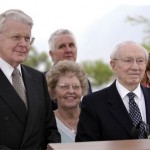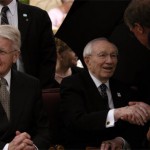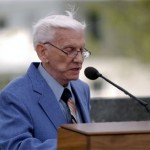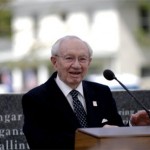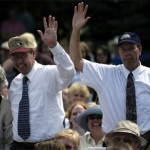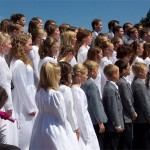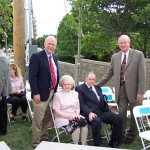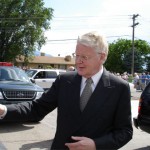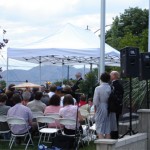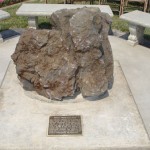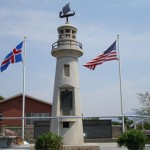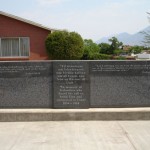Icelandic Memorial, Spanish Fork, Utah
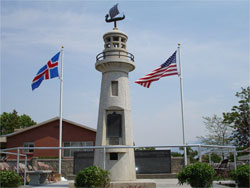
The Mormon Historic Sites Foundation helped support the Icelandic Association of Utah, Inc. to expand an outdoor memorial in Spanish Fork, Utah.
The memorial is located at 400 South 800 East in Spanish Fork and it’s dedication was part of the sesquicentennial celebration of June 23-26, 2005 to honor the 410 Icelanders who immigrated to Utah between 1855 and 1914.
The project included landscaping, adding benches and seating, moving a one-ton rock from the Westmann Island in Iceland to Spanish Fork, adding interactive story plaques telling the story of Icelandic pioneers who immigrated to Utah, and creating a “Wall of Honor” memorial. This memorial is similar to the monument placed on the Westmann Islands in Iceland in 2000 and includes the names of the 410 immigrants who came to Utah.
Photos
Articles & Resources
Iceland memorial ceremony set
Author(s): Rodger Hardy
Published in: Deseret Morning News
Publication Date: June 20, 2005

Photo by Keith Johnson, Deseret Morning News
SPANISH FORK — LDS Church President Gordon B. Hinckley will dedicate a refurbished memorial made in honor of settlers from Iceland on Saturday.
Olafur Ragnar Grimmson, the president of Iceland, will also be at the 3 p.m. dedication. It will be the second trip he’s made to Spanish Fork; the first was his visit in 1997 for the Icelandic Association of Utah’s centennial anniversary.
The memorial, a lighthouse built in 1938, continues to bind folks with Icelandic heritage, said David Ashby, a spokesman for the association. The lighthouse is not only symbolic of a seafaring people, but also represents the light shown on the world through the religious convictions of those early settlers, who were LDS converts.
The city’s settlers left Iceland in 1854 and arrived in Utah in 1855.
Icelandic members of The Church of Jesus Christ of Latter-day Saints kept coming — at least 410 of them — until 1914 when LDS missionaries were pulled out of Iceland.
New research indicates that more than 410 Icelanders may have immigrated to Spanish Fork during that time, Ashby said.
LDS missionaries weren’t allowed to return to Iceland until 1975.
The first Icelandic settlers’ conversion and subsequent migration to America cannot be separated, he said. It also launched a general migration of Icelanders to North America during the rough financial climate in Iceland at the time.
The refurbished monument, which President Hinckley will dedicate as the Icelandic Memorial, includes the names of those first 410 immigrants engraved on a marble wall.
A rock near a pond at the edge of the Atlantic Ocean where early converts were baptized was shipped to Spanish Fork to be part of the memorial.
Surrounding the rock, landscapers are installing eight plaques on an octagon that describe the Icelandic experience in coming to Spanish Fork.
One tells how they built a church in 1887 where they held services in Icelandic.
When the lighthouse monument was built, it had a working light. That light hasn’t worked for years, Ashby said. Crews restored the light by running an underground power line to it.
“The lighthouse helped preserve our heritage. It’s still a symbol for (Icelandic) descendants,” he said.
The dedication is part of a four-day celebration that will begin Thursday at 7 p.m. with a cowboy-style barbecue at the city park behind the Spanish Fork Library to honor the western culture in which the first settlers found themselves.
On Friday, beginning at 10 a.m., several presenters will describe the Icelandic culture and history that remains important to the descendants of those pioneers. That will be held at an LDS Church at 1006 E. 200 South.
The memorial dedication follows on Saturday at 400 South and 800 East.
At 7 p.m. an Icelandic choir of about 50 voices will perform at the Provo Tabernacle, 100 S. University Ave.
Another 50 Icelanders, including friends, spouses and an Icelandic National League of Iceland tour group, are also expected, Ashby said.
“We’re extremely fortunate to have these people come over and rub shoulders with them,” association committee member Jack Tobiasson said. “It builds bridges.”
An evening devotional, at the 1006 E. 200 South LDS church in Spanish Fork, begins at 7 p.m. Speakers include Janette Hales Beckham, former general president of the LDS Church’s Young Women’s organization and a descendant of Icelandic immigrants.
Other speakers are Kristy Robertson, president of the Utah Icelandic Association and Craig Holdaway, who recently returned from an LDS mission to Iceland.
Pres. Hinckley, Iceland leader dedicate Sp. Fork memorial
Author(s): Rodger Hardy
Published in: Deseret Morning News
Publication Date: June 26, 2005
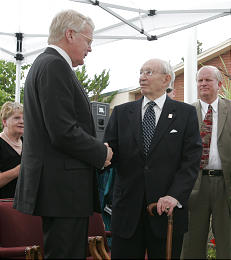
Photo by Jason Olsen, Deseret Morning News
SPANISH FORK — President Gordon B. Hinckley of The Church of Jesus Christ of Latter-day Saints rededicated a memorial on Saturday to the first pioneers from Iceland who began settling the region 150 years ago.
The president of Iceland, Olafur Ragnar Grimsson, participated, marking his second visit to Spanish Fork since 1997, when he came to observe the 100-year celebration of the Icelandic Association of Utah.
The memorial includes a lighthouse replica and marble wall with the first 410 settlers’ names inscribed on it. The dedication ceremony was marked by weather that ranged from sunny to overcast skies, wind and rain, in quick succession. “For us in Iceland that is no surprise,” Grimsson said of the weather. “Those who came here 150 years ago would have felt right at home.”
The first Icelanders were converted to the LDS Church is 1851. They were baptized in a pool that would form on the North Atlantic seashore of the Westmann Islands when the tide was out. A rock from the site was shipped to Spanish Fork and became part of the Icelandic Memorial, first constructed in 1936. More than 2,000 people attended the rededication.
When they arrived in Salt Lake City in 1855, Brigham Young sent the Icelanders to settle Spanish Fork with other Europeans. But unlike other settlers, the Icelanders kept their heritage and identity, President Hinckley said.
The LDS converts made the trip until 1914 when the Icelandic mission was shut down because of World War I. At first the settlers lived in dugouts but then developed farms.
“They had a better life than they had known in Iceland,” he said.
Speaking to the descendants of those pioneers, “with the blood of the Vikings in your veins,” President Hinckley lauded their forebears for becoming “a credit to this nation.”
In his dedicatory prayer, President Hinckley recounted the history of those early converts and their accomplishments in settling Spanish Fork. He prayed for Iceland and its freedom and democracy and also for America and President Bush.
“May (the Icelandic Memorial) remain sacred in the eyes of all and a constant reminder of the faith . . . of those early pioneers,” he said.
The first Icelanders left their native land under uncertain conditions, Grimsson said. When they arrived in what was to become Spanish Fork “this was a dismal place, a desert,” he said.
“They came here with nothing 150 years ago but were able to create a legacy that makes us very proud,” he said.
The Iceland of that era was among the poorest countries in the world, he said. Icelanders then were mostly fishermen and farmers.
In 2000, the Spanish Fork descendants put up a sister memorial in Iceland, which strengthened the bond between them.
“We are one family in spirit, in faith, in heritage and in vision,” Grimsson said.
Consul of Iceland J. Brent Haymond noted that when his ancestors left Iceland “they slammed the door.” Until meetings began with Grimsson, “We didn’t know if we were still part of that Viking family.”
Bridges have been built between the two countries through the rededication of the memorial, Icelandic Association of Utah President Kristy Robinson said. Bridges were also reinforced between generations, she added.
Other dignitaries at the rededication were Lt. Gov. Gary Herbert and Rep. Chris Cannon, R-Utah. Herbert said he was impressed by the love the descendants of those first Icelanders had for their ancestors and the people of Iceland today.
Earlier in the day, Grimsson met with officials, staff and international students at a Utah Valley State College breakfast meeting where he related the economic successes Iceland is having.
“The best option is to be rooted in Iceland, but operate globally,” he said of his countrymen who use technology to compete in business.
He predicted more economic success with American-style competition than with the unification force of the European Union.

